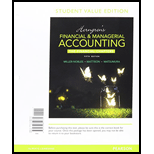
Horngren's Financial & Managerial Accounting, The Financial Chapters (Book & Access Card)
5th Edition
ISBN: 9780134078939
Author: Tracie L. Miller-Nobles, Brenda L. Mattison, Ella Mae Matsumura
Publisher: PEARSON
expand_more
expand_more
format_list_bulleted
Concept explainers
Question
Chapter 7, Problem 15RQ
To determine
Timing Differences: When accounting records are maintained by both bank and business, time interval occurs and thus cash differences occur between cash amount in the bank statement and the cash account in the company books. These time intervals are referred as timing differences.
To list: Some examples of timing differences.
Expert Solution & Answer
Want to see the full answer?
Check out a sample textbook solution
Students have asked these similar questions
None
For the year, Imperial Corp.'s gross profit is $210,000, sales are $350,000, and ending inventory is $80,000. If net purchases are $120,000, what is the COGS? a. $110,000 b. $140,000 c. $150,000 d. $160,000
Under absorption costing what would be the value of the ending inventory?
Chapter 7 Solutions
Horngren's Financial & Managerial Accounting, The Financial Chapters (Book & Access Card)
Ch. 7 - Prob. 1QCCh. 7 - Prob. 2QCCh. 7 - Prob. 3QCCh. 7 - Prob. 4QCCh. 7 - Prob. 5QCCh. 7 - Prob. 6QCCh. 7 - Prob. 7QCCh. 7 - Prob. 8QCCh. 7 - Prob. 9QCCh. 7 - Prob. 10QC
Ch. 7 - Prob. 1RQCh. 7 - Prob. 2RQCh. 7 - What are the five components of internal control?...Ch. 7 - Prob. 4RQCh. 7 - What is separation of duties?Ch. 7 - Prob. 6RQCh. 7 - Prob. 7RQCh. 7 - Prob. 8RQCh. 7 - How do businesses control cash receipts by mail?Ch. 7 - Prob. 10RQCh. 7 - Prob. 11RQCh. 7 - Prob. 12RQCh. 7 - Prob. 13RQCh. 7 - Prob. 14RQCh. 7 - Prob. 15RQCh. 7 - Prob. 16RQCh. 7 - Prob. 17RQCh. 7 - Defining internal control Internal controls are...Ch. 7 - Prob. 7.2SECh. 7 - Prob. 7.3SECh. 7 - Prob. 7.4SECh. 7 - Prob. 7.5SECh. 7 - Prob. 7.6SECh. 7 - Prob. 7.7SECh. 7 - Prob. 7.8SECh. 7 - Prob. 7.9SECh. 7 - Prob. 7.10SECh. 7 - Prob. 7.11ECh. 7 - Prob. 7.12ECh. 7 - Prob. 7.13ECh. 7 - Evaluating internal control over cash payments...Ch. 7 - Understanding internal control, components,...Ch. 7 - Prob. 7.16ECh. 7 - Prob. 7.17ECh. 7 - Prob. 7.18ECh. 7 - Prob. 7.19ECh. 7 - Prob. 7.21APCh. 7 - Prob. 7.22APCh. 7 - Prob. 7.23APCh. 7 - Prob. 7.24APCh. 7 - Prob. 7.25APCh. 7 - Prob. 7.26APCh. 7 - Prob. 7.27BPCh. 7 - Prob. 7.28BPCh. 7 - Prob. 7.29BPCh. 7 - Prob. 7.30BPCh. 7 - Prob. 7.31BPCh. 7 - Prob. 7.32BPCh. 7 - Prob. 7.33CPCh. 7 - Prob. 7.34PSCh. 7 - Prob. 7.2CTDCCh. 7 - Levon Helm was a kind of one-man mortgage broker....Ch. 7 - Prob. 7.1CTCA
Knowledge Booster
Learn more about
Need a deep-dive on the concept behind this application? Look no further. Learn more about this topic, accounting and related others by exploring similar questions and additional content below.Similar questions
- I am looking for the correct answer to this general accounting question with appropriate explanations.arrow_forwardI am looking for the correct answer to this general accounting question with appropriate explanations.arrow_forwardCan you help me solve this general accounting question using the correct accounting procedures?arrow_forward
- Nonearrow_forwardBoston Furniture Co. produces a single product. Variable production costs are $18 per unit, and variable selling and administrative expenses are $7 per unit. Fixed manufacturing overhead totals $62,000, and fixed selling and administration expenses total $48,000. Assuming a beginning inventory of zero, production of 6,500 units and sales of 5,800 units, the dollar value of the ending inventory under variable costing would be: a. $9,000 b. $12,600 c. $15,300 d. $18,700arrow_forwardI need help solving this general accounting question with the proper methodology.arrow_forward
arrow_back_ios
SEE MORE QUESTIONS
arrow_forward_ios
Recommended textbooks for you
 College Accounting (Book Only): A Career ApproachAccountingISBN:9781337280570Author:Scott, Cathy J.Publisher:South-Western College Pub
College Accounting (Book Only): A Career ApproachAccountingISBN:9781337280570Author:Scott, Cathy J.Publisher:South-Western College Pub Auditing: A Risk Based-Approach (MindTap Course L...AccountingISBN:9781337619455Author:Karla M Johnstone, Audrey A. Gramling, Larry E. RittenbergPublisher:Cengage Learning
Auditing: A Risk Based-Approach (MindTap Course L...AccountingISBN:9781337619455Author:Karla M Johnstone, Audrey A. Gramling, Larry E. RittenbergPublisher:Cengage Learning EBK CONTEMPORARY FINANCIAL MANAGEMENTFinanceISBN:9781337514835Author:MOYERPublisher:CENGAGE LEARNING - CONSIGNMENTPrinciples of Accounting Volume 1AccountingISBN:9781947172685Author:OpenStaxPublisher:OpenStax College
EBK CONTEMPORARY FINANCIAL MANAGEMENTFinanceISBN:9781337514835Author:MOYERPublisher:CENGAGE LEARNING - CONSIGNMENTPrinciples of Accounting Volume 1AccountingISBN:9781947172685Author:OpenStaxPublisher:OpenStax College

College Accounting (Book Only): A Career Approach
Accounting
ISBN:9781337280570
Author:Scott, Cathy J.
Publisher:South-Western College Pub

Auditing: A Risk Based-Approach (MindTap Course L...
Accounting
ISBN:9781337619455
Author:Karla M Johnstone, Audrey A. Gramling, Larry E. Rittenberg
Publisher:Cengage Learning


EBK CONTEMPORARY FINANCIAL MANAGEMENT
Finance
ISBN:9781337514835
Author:MOYER
Publisher:CENGAGE LEARNING - CONSIGNMENT


Principles of Accounting Volume 1
Accounting
ISBN:9781947172685
Author:OpenStax
Publisher:OpenStax College